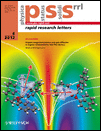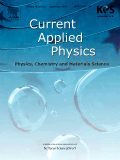
Advanced Electronic Materials
metrics 2024
Leading the Charge in Materials Science Exploration
Introduction
Advanced Electronic Materials is an esteemed journal published by Wiley, dedicated to the forefront of materials science, particularly in the areas of electronic, optical, and magnetic materials. With a commendable impact factor that places it in the Q1 quartile of its category and a Scopus rank of 36 out of 284, the journal is a vital resource for researchers, professionals, and students aiming to contribute to this rapidly evolving field. Launched in 2015 and fully transitioned to Open Access in 2023, the journal promotes widespread dissemination of knowledge, ensuring accessibility to groundbreaking research findings. With its address located in Germany at 111 River St, Hoboken 07030-5774, NJ, it serves a global academic community eager to explore innovative materials technologies that influence diverse applications ranging from consumer electronics to advanced manufacturing. As researchers seek to push the boundaries of what is possible with materials, Advanced Electronic Materials stands as a premier platform for sharing, discovering, and advancing knowledge in this essential domain.
Metrics 2024
 1.69
1.69 5.30
5.30 6.60
6.60 92
92Metrics History
Rank 2024
Scopus
IF (Web Of Science)
JCI (Web Of Science)
Quartile History
Similar Journals

JOURNAL OF MATERIALS SCIENCE-MATERIALS IN ELECTRONICS
Advancing the Frontiers of Materials in ElectronicsJOURNAL OF MATERIALS SCIENCE-MATERIALS IN ELECTRONICS, published by Springer, is a distinguished international journal that serves as a vital platform for the dissemination of cutting-edge research in the field of materials science, with a keen focus on electronics. Since its inception in 1990, this journal has consistently contributed to the advancement of knowledge across a range of interdisciplinary categories, including Atomic and Molecular Physics, Optical and Magnetic Materials, and Biomedical Engineering, achieving notable quartile positions in various 2023 Scopus rankings. With an impact factor that signifies its scholarly influence, this journal provides a rigorous peer-reviewed environment for researchers and practitioners to share innovative ideas, experimental findings, and theoretical developments. Although it does not currently offer open access options, the depth and breadth of topics covered—including condensed matter physics and bioengineering—make it an essential resource for those at the forefront of materials research. With a commitment to bridging the gap between theory and practical application, the JOURNAL OF MATERIALS SCIENCE-MATERIALS IN ELECTRONICS continues to pave the way for future explorations in the ever-evolving landscape of materials science.

Physica Status Solidi-Rapid Research Letters
Driving Breakthroughs in Condensed Matter ResearchPhysica Status Solidi-Rapid Research Letters is a distinguished peer-reviewed journal published by WILEY-V C H VERLAG GMBH that serves as a critical platform for the rapid dissemination of research in the domains of Condensed Matter Physics and Materials Science. Since its inception in 2007, the journal has maintained an impressive Q2 ranking in both relevant categories, underscoring its significant impact within the scientific community. With an E-ISSN of 1862-6270, it offers insightful contributions to the understanding of advanced materials and their applications, attracting a global audience of researchers, professionals, and students. Although not an open-access journal, it is recognized for its rigorous review process and high-quality publications that push the boundaries of knowledge. By encouraging the exchange of innovative ideas and findings, Physica Status Solidi-Rapid Research Letters continues to solidify its role as an essential resource in fostering scientific advancements.

INFORMACIJE MIDEM-JOURNAL OF MICROELECTRONICS ELECTRONIC COMPONENTS AND MATERIALS
Advancing Microelectronics: Bridging Research and InnovationINFORMACIJE MIDEM - JOURNAL OF MICROELECTRONICS ELECTRONIC COMPONENTS AND MATERIALS is a prominent open-access journal published by SOC MICROELECTRONICS, ELECTRON COMPONENTS MATERIALS-MIDEM in Slovenia, dedicated to advancing knowledge in the fields of microelectronics, electronic components, and materials. Since its inception in 1988, the journal has provided a platform for groundbreaking research and innovations, ensuring that all published work is freely accessible to a global audience. With an impressive history of publication from 1996 to 2024, INFORMACIJE MIDEM is indexed in Scopus, holding respectable ranks in categories such as Electrical and Electronic Engineering (Rank #525/797, Percentile 34th) and Electronic, Optical, and Magnetic Materials (Rank #204/284, Percentile 28th). While currently classified in the Q4 quartile for the year 2023, the journal serves as an essential resource for researchers, professionals, and students seeking the latest developments in microelectronics and related fields, fostering a collaborative academic environment and contributing to the advancement of technology and materials science.

CURRENT APPLIED PHYSICS
Illuminating the Path of Applied Physics Research.Current Applied Physics is a leading journal published by Elsevier, specializing in the dynamic fields of Physics and Materials Science. With an ISSN of 1567-1739 and an E-ISSN of 1878-1675, this journal focuses on the latest advancements and applications of physics principles in various practical domains. Operating from the innovative hub of Amsterdam, Netherlands, Current Applied Physics occupies a significant niche in the scientific community, evidenced by its Q2 ranking in both the Physics and Astronomy and Materials Science categories for the year 2023, along with impressive Scopus rankings that highlight its relevance in the fields of General Physics and General Materials Science. The journal's scope encompasses a wide range of topics, fostering interdisciplinary collaboration and facilitating the exchange of knowledge among researchers, professionals, and students. Each issue features peer-reviewed articles that contribute to the understanding and application of physical sciences, making it an essential resource for those aiming to stay at the forefront of research and innovation in applied physics.

ACS Applied Electronic Materials
Transforming Research into Real-World ApplicationsACS Applied Electronic Materials, published by the American Chemical Society, is a prominent journal in the field of applied materials science, with a particular focus on electronic, optical, and magnetic materials. Established in 2019, this journal has quickly risen to prominence, achieving a 2023 ranking of Q1 in both Electronic, Optical and Magnetic Materials and Materials Chemistry, as well as Q2 in Electrochemistry, reflective of its high-quality contributions and significant impact within the scholarly community. With an impressive Scopus rank of #22 in Electrochemistry, #59 in Electronic, Optical and Magnetic Materials, and #75 in Materials Chemistry, ACS Applied Electronic Materials serves as an essential resource for researchers, professionals, and students seeking to explore innovative advancements in the field. While the journal is not open access, it offers robust subscription options and aims to foster the dissemination of cutting-edge research articles, reviews, and technical notes that contribute to the understanding and application of electronic materials in various technological contexts. As a platform for pioneering research and cross-disciplinary dialogue, this journal is indispensable for anyone invested in the future of materials science.

InfoMat
Elevating Knowledge in Materials Science with Every PublicationInfoMat is a premier open-access journal published by WILEY that serves as a vital resource for scholars and practitioners in the fields of materials science, materials chemistry, and related disciplines. Since its inception in 2019, this journal has rapidly ascended in academic stature, currently holding a prestigious Q1 ranking across multiple categories, including Electronic, Optical and Magnetic Materials, Materials Chemistry, and Surfaces, Coatings and Films, showcasing its significant impact and relevance. With a commendable impact factor and a comprehensive scope, InfoMat provides a platform for high-quality research that drives innovation in the materials domain, appealing to researchers, professionals, and students alike. The journal’s open-access model enhances visibility and accessibility of cutting-edge studies, fostering a collaborative and informed scientific community. Based in the United Kingdom, InfoMat continues to shape the future of materials research through its commitment to excellence and accessibility.

Nano Materials Science
Advancing the Frontiers of Nanotechnology.Nano Materials Science is a premier open-access journal dedicated to the dissemination of groundbreaking research in the fields of nanotechnology, materials science, and chemical engineering. Published by KEAI PUBLISHING LTD, this journal has quickly established itself as a leading platform in its area since its inception in 2019, with impressive rankings in the Scopus database, holding a Q1 position across multiple categories, including Chemical Engineering and Materials Science. Based in Beijing, China, Nano Materials Science provides researchers and practitioners access to a wealth of high-quality peer-reviewed articles, fostering innovation and collaboration within the scientific community. With its impact factor steadily rising and a commitment to open access, the journal aims to bridge the gap between theoretical research and practical applications, making it an essential resource for professionals and students eager to stay at the forefront of materials research and nanotechnology advancements.

SEMICONDUCTORS
Advancing the frontiers of semiconductor research.SEMICONDUCTORS, published by PLEIADES PUBLISHING INC, is a prominent journal that provides a platform for researchers and professionals in the fields of Atomic and Molecular Physics, Condensed Matter Physics, and Electronic, Optical and Magnetic Materials. With an ISSN of 1063-7826 and an E-ISSN of 1090-6479, the journal has been diligently disseminating knowledge since its inception in 1996 and continues to pave the way for innovative research until 2024. Although currently unclassified in the Open Access model, its influence is underscored by its rankings in Scopus, where it ranks in the 21st-22nd percentile across critical scientific categories. SEMICONDUCTORS serves as an essential resource for cutting-edge research, fostering a greater understanding of semiconductor materials and their applications, thereby assisting the scientific community in pushing the boundaries of technology and innovation.

Electronic Materials Letters
Exploring Breakthroughs in Electronic MaterialsElectronic Materials Letters is a distinguished journal dedicated to the dissemination of research in the field of electronic, optical, and magnetic materials. Published by the Korean Institute of Metals and Materials, this journal has established itself as a critical platform for scholars and practitioners since its inception in 2008, with coverage extending through 2024. With an ISSN of 1738-8090 and an E-ISSN of 2093-6788, it has achieved a commendable Q3 categorization for 2023, ranking 107 out of 284 in the Scopus database's specialized field, reflecting its relevance with a 62nd percentile position among its peers. Although this journal operates under a traditional access model, its rigorous peer-review process ensures that only the most impactful research reaches its audience, thereby maintaining high scholarly standards. Positioned in South Korea at the heart of technological innovation, Electronic Materials Letters plays a vital role in bridging the gap between theoretical investigations and practical applications, making it an essential resource for researchers, industry professionals, and students aiming to thrive in the rapidly evolving materials science landscape.

JOURNAL OF OPTOELECTRONICS AND ADVANCED MATERIALS
Advancing the Frontiers of Optoelectronics and Materials ScienceJOURNAL OF OPTOELECTRONICS AND ADVANCED MATERIALS, published by the NATL INST OPTOELECTRONICS in Romania, is an esteemed academic journal dedicated to disseminating innovative research in the fields of optoelectronics and advanced materials. With an ISSN of 1454-4164 and E-ISSN 1841-7132, the journal provides a platform for researchers to share their findings and technological advancements from 1999 to 2024. Despite being placed in the Q4 quartile across several categories—including Atomic and Molecular Physics, Condensed Matter Physics, and Electrical and Electronic Engineering—the journal serves as an essential resource for highlighting significant developments in its respective fields. Researchers and professionals may find valuable insights that foster collaboration and inspire further investigation, thereby contributing to the continuous evolution of optoelectronics and materials science.